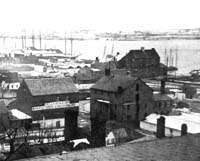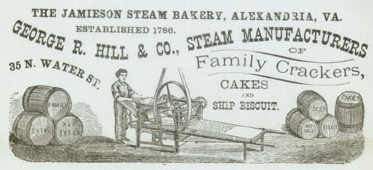



Jamieson Bakery building, in existance from c1836-1888. For more information on the three story cracker factory, which used steam driven machines, see below, from the Alexandria Archaeology Museum, which also is the source of the pictures. The Civil War era photograph on left is "courtesy U.S. Army Military History Institute, Carlisle Barracks, Pa." One of the speakers at The Lyceum Museum's Food History Symposium on Jan 23,will discuss the bakery.
From the Alexandria Archaeology Museum website:
Just north of the project area, at Lee and Oronoco streets, Scotland native Andrew Jamieson began baking an assortment of best white biscuits or crackers in 1785. He later moved his bake-house to Ramsay's Wharf at King and Union streets. Andrew's son, Robert, joined the firm in 1821 and continued the business after his father's death. By 1836, the bakery had moved to the project area, to a three-story brick building at the northeast corner of Lee Street and Thompson's Alley. It has been said that Jamieson made Alexandria famous by his crackers. The products must have been highly esteemed as Queen Victoria as a young woman so relished them that she imported them for the Royal table.
The Jamieson bakery was a large manufactory for the time, with twelve employees and $24,000 capital invested by 1850. That year, Robert Jamieson purchased 4900 bushels of flour to produce $36,000 worth of crackers. Ten years later, despite the addition of a twelve-horsepower steam engine, the firm sold $6000 less of its product. Jamieson offered to lease his old Bakery House in 1856.
It is not known whether the Union army used the bakery during the Civil War, although a number of military structures were constructed on the block. Several months after the war, a fire broke out in the building. The bakery was apparently still serviceable in 1873, when George R. Hill purchased it and recommenced baking crackers. Later, Hill moved his operation across Lee Street to an old mill. The bakery was torn down in 1888 to make room for the wholesale warehouses of Charles King and Son, which eventually covered (and preserved) the entire half block.
The brick footings of the late nineteenth-century warehouses were unearthed beneath the asphalt parking lot. And under these, the massive stone foundations of the three-story brick bakery of Robert Jamieson were discovered. Three rooms comprised the main floor. North of the bakery was a well, perhaps the earliest water supply for the building. The well-preserved brick domed cistern, located in the second room, was probably also used to supply water for baking and for the operation of a steam engine boiler used to heat the large rectangular ovens.
Additional information:
Traveler's Accounts of the Historic Alexandria Waterfront from 1624-1896